REMEMBERING LUM WENG HOE
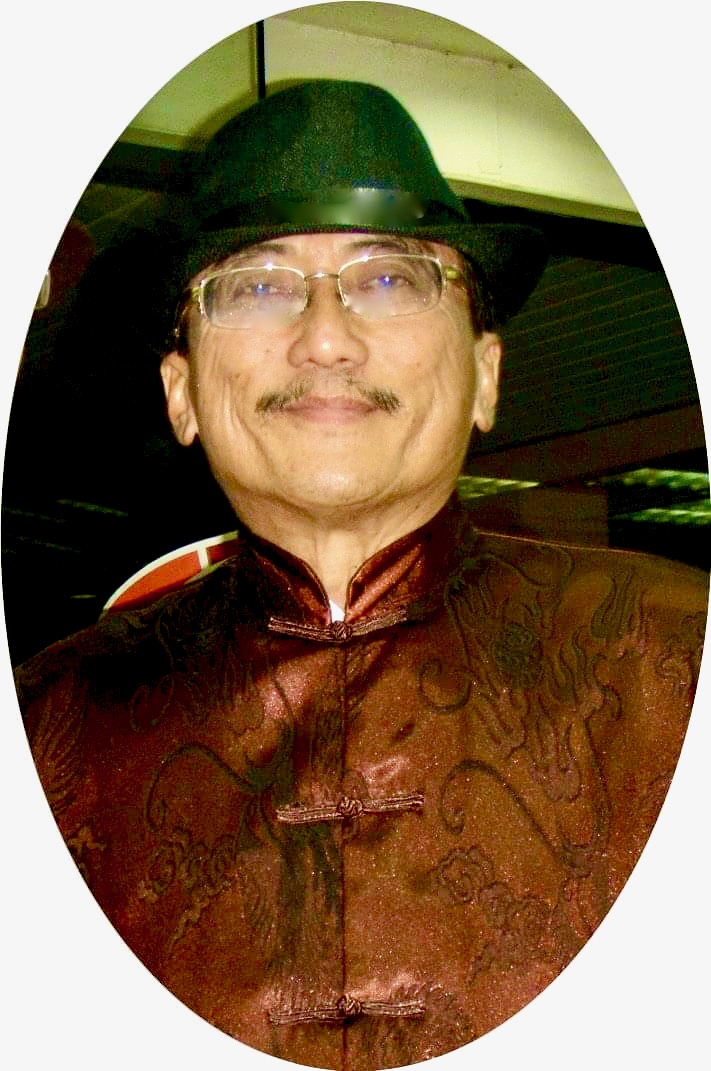
25 February 1949 to 05 November 2020
It has been half a century of restless service that Lum Weng Hoe had passionately rendered the Cause of Bahá’u’lláh. He had served the Cause wholly and wholeheartedly, as would be readily and undeniably acknowledged by those who had moved with him. His Creator has called Lum Weng Hoe to His realms on high perhaps for a wisdom only known to Him. History would have it that Weng Hoe, as he was called, resisted accepting the Faith when the Healing Message of Bahá’u’lláh wafter over him. But Weng Hoe’s own will was overpowered by the superior Divine Will and from the time Weng Hoe accepted the Faith, he served the Cause with such a commitment, passion, and devotion, that came to be appreciated and admired by many institutions and numerous individuals.
Weng Hoe was the third child out of seven siblings. His father Mr. Lum Theam Fatt was a civil servant with the Ministry of Home Affairs in the Government of Malaysia and was assigned to the Police Department. As a civil servant it was normal to be transferred to several duty stations right to the retirement age. Mr. Theam Fatt was thus transferred from Penang island to the towns of Seremban, Alor Star, Ipoh and finally to the capital city of Kuala Lumpur where he retired as a senior officer. It was while in Penang that the first six Lum brothers were born, and the last was born in Alor Star. Lum Weng Hoe studied at the Sultan Abdul Hamid College for three years where, as a very active member in the Scout movement he picked up skills that he would later use, such as gardening and handyman. He next underwent a science course in the Penang Technical Institute. His first was a temporary job with a Chinese company in Ipoh. That was as a Lab Researcher conducting field studies on soil. He then secured a job for a short stint as a Sales Representative in Rex Rotary, a company dealing with office machines. When Weng Hoe got a job in William Jacks, a trading company in Petaling Jaya, he moved into Petaling Jaya.
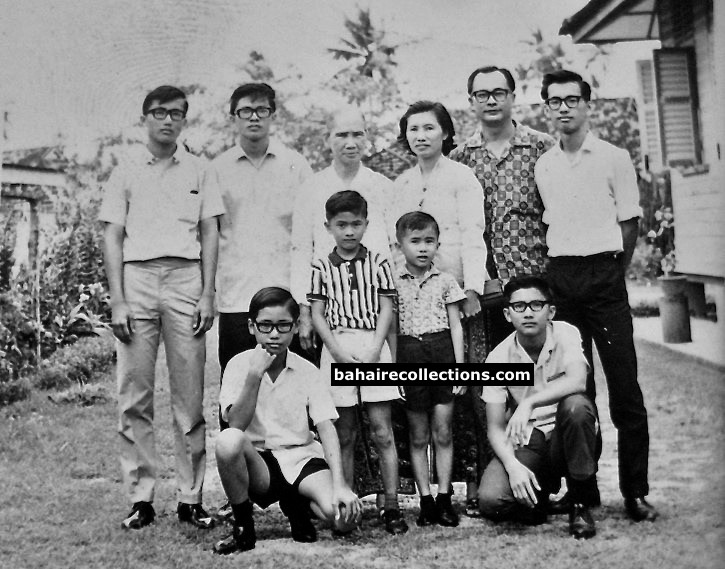
A 1970 family photo taken in Jalan Langar Alor Star. Back row L-R: Lum Weng Hoe, Lum Weng Chuen, their Madam Wong Choon Kum (grandmother) and parents Mrs. Yap Yoke Cheng and Mr. Lum Theam Fatt, and Lum Weng Chew. Front row L-R: Lum Weng Hup, Lum Weng Kuan, Lum Weng Yew and Lum Weng Tuck
His elder brother Lum Weng Chew had accepted the Faith as a student at the Sultan Abdul Hamid College in Alor Star on 29 May 1966 and moved to reside in Petaling Jaya to take up a degree course in University Malaya. Lum Weng Chew was the Secretary of the Local Spiritual Assembly of Petaling Jaya from 1972 to 1976. Lum Weng Chew was renting a room in the Petaling Jaya Bahá’í Centre at 8, Jalan Padang, which was also the home of Senior Police Inspector Leong Ho Chiew, the eldest son of Leong Tat Chee and the first Auxiliary Board member of Malaysia. Weng Hoe, by this time was still not a believer. Mr. V. Theenathayalu, a believer of Alor Star town had moved into Petaling Jaya and presented him the Faith. But Weng Hoe was quite reluctant as uppermost in his mind was building up a good career first. He then transferred his residence to the Happy Gardens to escape accepting the Faith, not realising that he was destined to be spiritually trapped there! When he moved to the Happy Gardens, he did not realise that the persistent Bahá’í teacher Mr. S. L. Thevar was residing in his neighbourhood. Mr. and Mrs. Thevar who had learnt that Weng Hoe was the younger brother of Lum Weng Chew invited him for breakfasts, lunches, and dinners frequently. Weng Hoe soon realised that the Thevars showered sincere and genuine love upon him and had no kind of ultimate motive. Weng Hoe attended the firesides that were held regularly at the residence of the Thevars. After reading and investigating further, Weng Hoe finally accepted the Faith on 7 September 1972, and there was no turning back. As Happy Gardens was administratively under the jurisdiction of the Local Spiritual Assembly of Petaling Jaya, the Assembly was most happy to welcome this inspired believer into the Faith. In the September 1972 issue of its official newsletter THE SATELLITE, the Assembly announced the enrolment of new believers and Weng Hoe’s name was on that list. The rest was half a century of history that he wrote with constant and relentless service to the Cause on many areas and aspects. This servant became a great asset for the Cause in Petaling Jaya when he alongside with other youths were called the “Shining Lights”. His two other younger brothers—Lum Weng Hup and Lum Weng Kuan too accepted the Faith and served the Cause well in later years.
From the day Weng Hoe accepted the Cause his passion turned to field teaching. He was one of the early believers in Petaling Jaya to buy a car starting with a white coloured mini minor and later a green coloured Toyota Corolla to go places for teaching. When the opening of Klang town was entrusted to the Petaling Jaya community, Weng Hoe used his cars to visit Klang almost each weekend. A teaching campaign known as “Operation Automobile” was conceived and introduced by the Hand of the Cause of God Dr. Rahmatu’lláh Muhájir in December 1974, and the Bahá’ís of Petaling Jaya made regular teaching trips to Klang and Kuala Selangor towns. Weng Hoe joined Miss Shirley Wong Mooi Nyuke, a local believer in Petaling Jaya, V. Theenathayalu and Elsa Monteiro to visit Klang constantly for two years. Finally, the difficult and yet important Klang was opened to the Faith with Mr. and Mrs. Tan Long Hock becoming the first to accept the Faith. Soon after a Local Spiritual Assembly was successfully formed in Klang town.
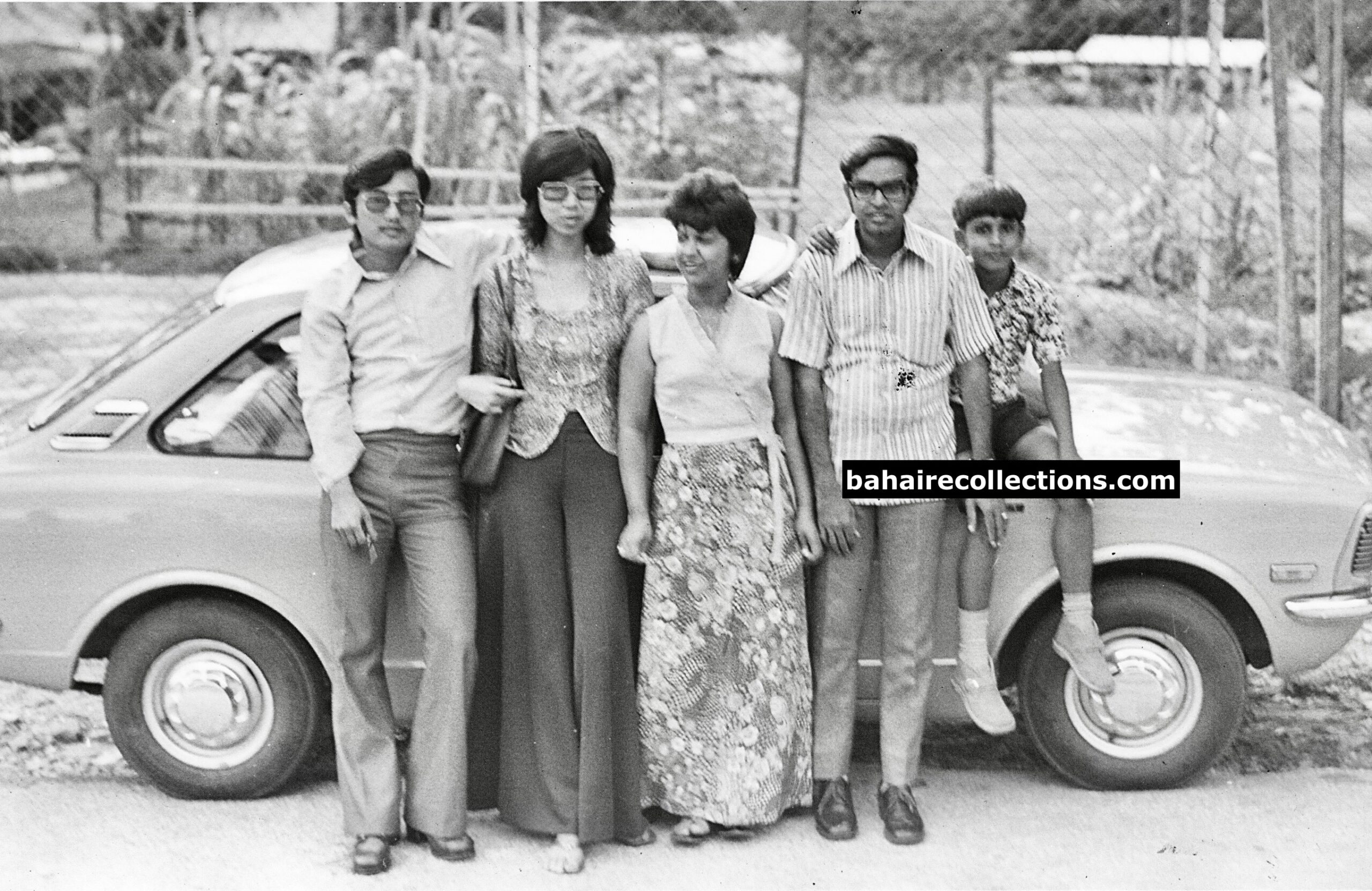
Operation Automobile Team, 1974. L-R: Weng Hoe, Shirley Wong, Elsa Monterio, Theenathayalu and son of Elsa
Weng Hoe and Shirley were natural lovers of field work, often teamed up to take part in local and national teaching activities. In mid-1970s the Bahá’ís of Petaling Jaya made frequent visits to the Bilut Valley over each weekend, stayed overnight and consolidated them. Lum Weng Hoe and Shirley Wong Mooi Nyuke were constantly on the move to consolidate this area. Weng Hoe had also committed to provide transportation for believers who had difficulty in coming for activities. He was one of the few who owned cars. He drove his Toyota Corolla car all the way to the University Malaya to bring along the undergraduate Bahá’ís there for activities in the Bahá’í Centre, a commitment and service the graduates still fondly remember.
Weng Hoe was elected to the Local Spiritual Assembly of Petaling and proved to be an able secretary, and a good administrator. He was admired and appreciated for keeping deliberations of the meetings of the Local Spiritual Assembly and each and every activity in that community in his personal notebook that he would never barter for anything. The annual reports that he drafted set a standard. When leaving the community for Kuantan, Pahang in 1975, the Local Spiritual Assembly of Petaling Jaya placed on record its appreciations for the annual reports that he had prepared during his tenure as secretary of the Assembly. Attached with the last annual report that he prepared was an appendix that carried an inventory of each and every item that was kept in the Bahá’í Centre. And that included every spoon, fork and even a single chopstick missing its pair. Even while serving as secretary of the Local Spiritual Assemblies in Petaling Jaya, and later in the towns of Kuantan and Subang Jaya, he was so committed that he slept very late on meeting days. He would never go to bed before completing the minutes of the meeting that took place. He would sleep at the wee hours of the night and get up at dawn to proceed to his office work.
There is one episode in the life of Weng Hoe, which to him was a turning point in its own way in his service to the Cause. William Jacks & Co. (M) Sdn. Bhd., a leading trading company in which he was working transferred him to the Kuantan branch in 1976, as the person working there was about to retire. His colleagues advised him against taking up the offer as it would be career wise suicidal with no possibility of climbing up the career ladder in what was considered a dead town in a faraway place. But Kuantan happened to be a goal area for the Petaling Jaya Bahá’í community and needed much assistance. Keeping the needs of the Faith uppermost in his mind, Weng Hoe took the offer and went to Kuantan. On the way to Kuantan, he passed a night in a hotel in a small town called Mentakab and prayed. It was Raymond Peter, one of the greatest teachers of the Faith in Malaysia who taught Weng Hoe how to tap on the power of divine assistance. Peter used to tell Weng Hoe, “ … Pray, pray, pray hard, focus to the task at hand and do pray like never before, and stay focused. The answer shall come from the prayer hearing and prayer answering God.” Weng Hoe went one step ahead and prayed from beginning of the prayer book to the last page, and from back to the front again. The next morning, he continued the journey to Kuantan feeling absolutely confident that divine assistance would assuredly come.
Arriving in Kuantan just before noon he found Kuantan to be a sleepy hollow with three main roads! He recalled what his skeptics at his workplace in Kuala Lumpur had cautioned and thought for a moment if they might be right after all. He nervously checked into a hotel on that first day, continued to pray hard and tried to focus to the task at hand. He started praying again from front to back and back to front of the prayer book.
His prayers were answered on the spot. He met the Malaysian Armed Forces believer Captain Munusamy and his wife Mrs. Teresa, and the Technician at the Telecommunications department Mr. R. Marriappan. He rented a room somewhere for a start and joined in the local community activities. Raymond Peter who was residing in Kuala Lumpur visited Captain Munusamy in the Armed Forces Kuantan and came over to meet Weng Hoe. Peter took a good look at his room and with keen spiritual intuition, and said, “Move out of this place, think big, rent a house, use it as the Bahá’í Centre. You are here for a purpose. It was not too much of the job you are plunged into. It is to serve the Faith. Have no more doubts. Just focus and pray, focus and pray. Other obstacles bothering you would soon come to pass. Do not be surprised when it comes and remember me when it comes.” Weng Hoe then resorted to reciting the “Tablet of Ahmad” several times.
Together they found a house at Taman Kubang Buaya off the road leading to Telok Chempedak Beach. That was more spacious and became a Bahá’í Centre and thus started a new wave of heightened activities. After two years the owner wants it back. Weng Hoe then rented another house at Jalan Mahmud, quite close to the previous one, this time a semi-detached double storey house which also became the Bahá’í Centre for the next three years. The already strongly emerging community became even stronger with a pair of devoted tenants moved into this house, that was none other than Francis Satkunasingam and his wife Usha.
From Kuantan he used to drive back to Petaling Jaya on most of the weekends to meet up with his brothers Lum Weng Chew, Lum Weng Hup and the local friends, not forgetting Shirley Wong whom he was courting. When Weng Hoe and Shirley became teaching partners, and it did not take long before they decided to become life partners as well. They wedded on 19 November 1976 at the Jaya Puri Hotel in Petaling Jaya, graced by the presence of the Hand of the Cause of God, Mr. Collis Featherstone, and his wife Madge. More than 500 friends gathered and that happened to be the biggest wedding crowd for the year. The couple ensured only plain water and Chinese tea were served as a substitute for the usual traditional wine for toast at the ten-course dinner. Mr. Featherstone gave a powerful talk at this wedding on the significance of the day in which we were living, touching the hearts of believers and non-believers.
After their marriage, Weng Hoe took his wife to Kuantan and stayed in a semi-detached house which also became the Bahá’í Centre for the next three years. Together with another couple Mr. Francis Satkunasingam and Usha Cheryan, and other believers like Kariipponon and Ponnusamy, they worked to build a dynamic Bahá’í community in Kuantan. With Francis Satkunasingam as Chairman and Weng Hoe as Secretary of the Assembly the administrative strength was enhanced. While in Kuantan Weng Hoe became the editor of a local Bahá’í newsletter called the “KUANTAN FLAME.” This newsletter received many accolades for the news items and the deepening materials it carried.

Weng Hoe weds Shirley
The first Bahá’í Summer School in Kuantan was held in July 1978. Weng Hoe had an important role to play at this summer school by joining forces with his fellow believers in turning that into a well-remembered and highly historical event. It was quite amazing to see the small band of believers in Kuantan taking on such a herculean task and executing it on a befitting manner, only to earn the appreciations of the Hand of the Cause of God Dr. Muhájir who graced the event. This event was also graced by Counsellors Inbum Chinniah and Yankee Leong of Malaysia and Vicente Samaniego of the Philippines.

Some members of the Kuantan community at the Summer School. Seated at extreme left is Yankee Leong. The three adults in the center are L-R: Jeyabalan, Ponnusamy, and Kariippanon. Standing L-R; (unknown) Bawani, Palimah, Ratha Jeyabalan, Madam Maria, Francis Singam, Counselor Vicente Samaniego from the Philippines and Lum Weng Hoe
It did not take long before the Kuantan Bahá’í community grew further into a vibrant one in the East Coast of Peninsula Malaysia. When Weng Hoe decided to take up the job offer in Kuantan he was cautioned that he had to forgo or forget any fortunes of promotion. But that was completely demystified through a miracle that Baháʼu’lláh performed. With Weng Hoe placing the Faith above everything else, his business grew four folds in the first year in Kuantan and by the end of his stint for 5 years, sales grew by an unbelievable ten-fold. Weng Hoe knew the source of the blessing, while his colleagues in Kuala Lumpur remained completely baffled!
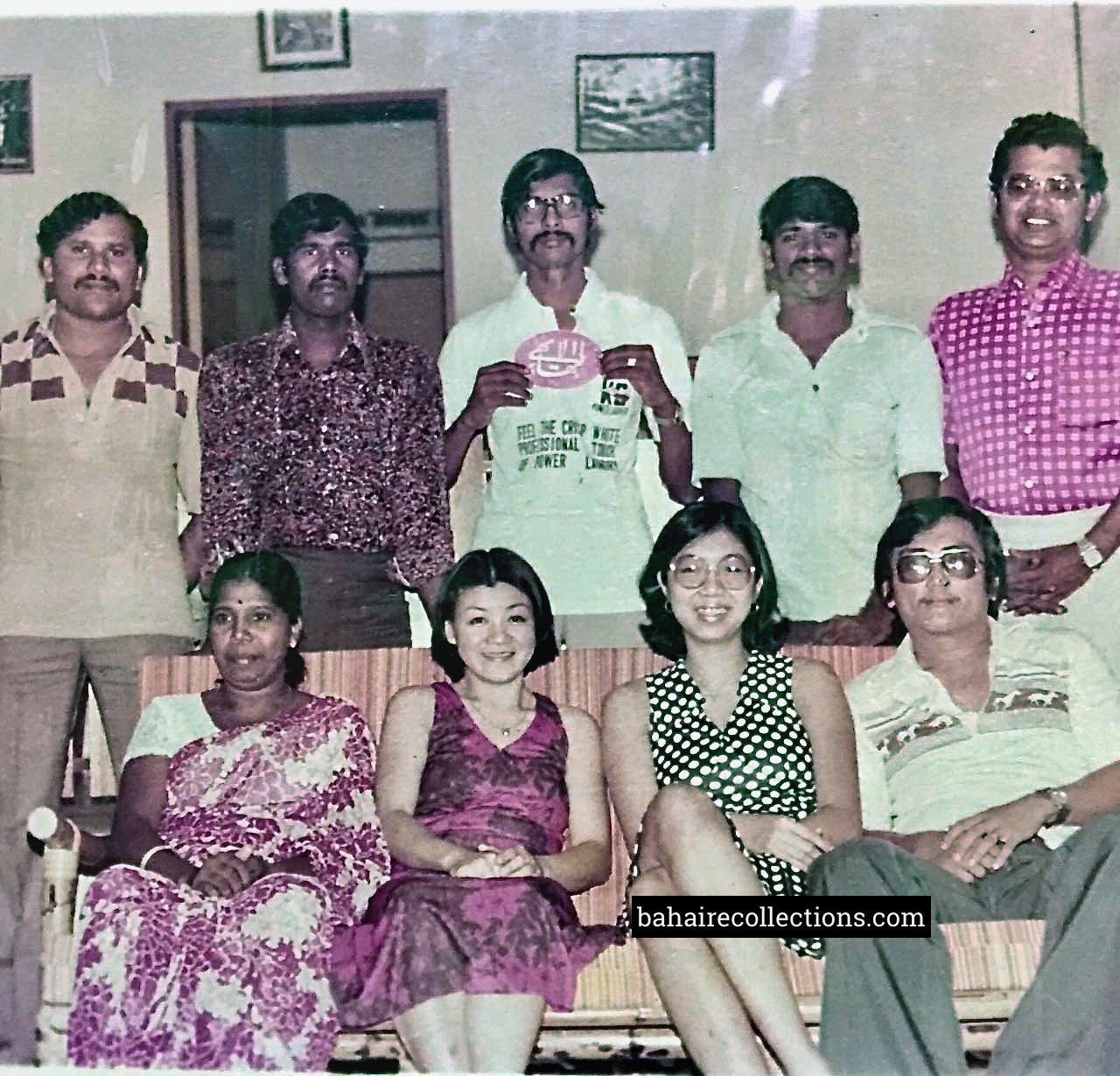
Local Spiritual Assembly of Kuantan, 1978. Back row L-R: Mohan, Ponnusamy, Jeyabalan, Kariippanon, and Francis. Seated L-R: Madam Maria, Bee Lee Goh, Shirley Wong, and Lum Weng Hoe

Sunday Children’s Class in Jeram Kuantan Estate in February 1977 during Intercalary Days for some 70 children. Weng Hoe stands second from right. Shirley Wong stands at the extreme left
Weng Hoe and Shirley returned to Kuala Lumpur in 1980. Weng Hoe served on the Local Spiritual Assembly of Kuala Lumpur in 1985 and 1986. They next settled in Subang Jaya in 1987. Subang Jaya was then under the Bahá’í administrative jurisdiction of Petaling Jaya. When the first Local Spiritual Assembly was formed for Subang Jaya in 1997, Weng Hoe and Shirley were elected to this divine institution. The couple served the Assembly with such devotion and commitment. He was on this assembly for right up to 2011.
In the first year of the establishment of the Local Spiritual Assembly in Subang Jaya in 1997, the Assembly established a local lending library. Weng Hoe, as an avid reader of Bahá’í books bought almost all new arrivals at the national Bahá’í bookshop and having read them contributed many of such materials to this local library. During these years he had served as Secretary or Assistant Secretary. As Secretary he produced annual reports with such detailed charts and photographs, setting high standards for any Local Spiritual Assembly. Weng Hoe took great pains in keeping in touch with each member of the community in sharing the messages from the Local Spiritual Assembly by way of personal telephone calls, emails, and SMS. He was indeed a very good communicator, always in touch with a wide range of friends through several forms of social media.
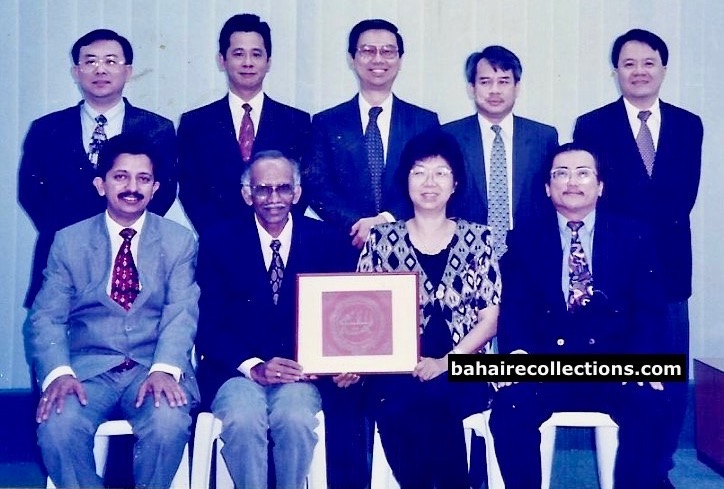
First Local Spiritual Assembly of Subang Jaya 1997. Standing L-R: Wee Pang Liang, Ronnie Koh, Dennis Chee, James Kijam and Anthony Wong. Seated L-R: Ramaish, Ravichandran, Shirley Wong and Weng Hoe
Weng Hoe had a good command of the English language which he kept polishing for the interest of the Faith. He enjoyed competing with another titan, Mr. Lim Kok Hoon, with whom he would play scrabble game. He was also a gifted writer and found the right avenue, when he was appointed first as Assistant Editor and effective 2002 as Chief Editor of the Subang Post, the official newsletter of the Subang Jaya community. He used to put in much painful efforts to produce this newsletter that shall ever be remembered as one of his greatest services for the Cause. As an official photographer he was actively involved in many local, regional, and national events to cover the events and take photographs to be published in the Subang Post. He was seen with camera and a sling bag that contained film rolls. All issues of the Subang Post were released on time for the Nineteen Day Feasts. He had all the skills, talents, and the making to be a good editor in the print media in the outside world, but his priority was the Cause. Till this day all subsequent editors draw the inspiration and examples from the high standards that Weng Hoe had set.
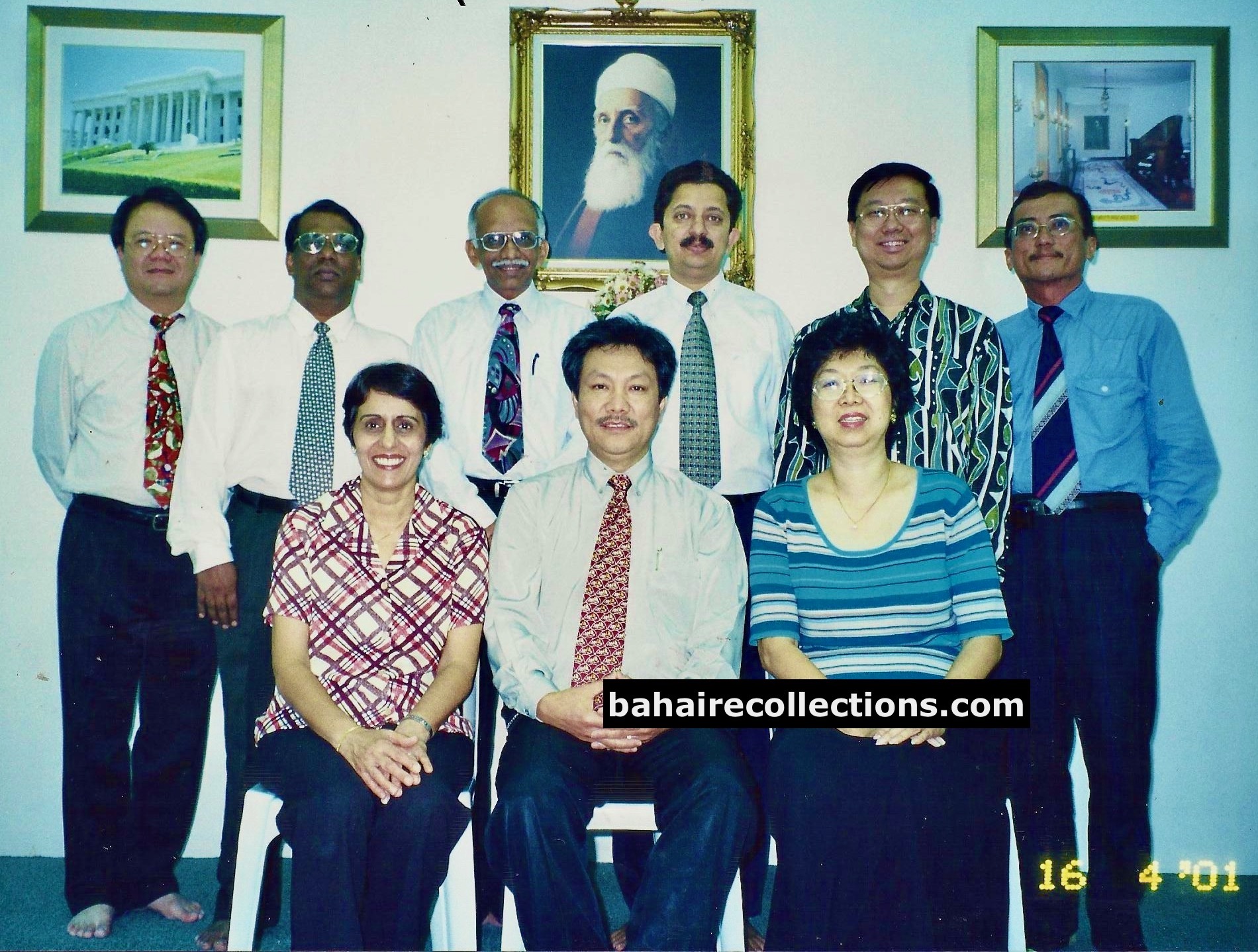 Local Spiritual Assembly of 2001. Standing L-R: Anthony Wong, Subromaniam, Ravichandran, Ramaish, Dennis Chee and Weng Hoe. Seated L-R: Parvaneh Lee, Paul Koh and Shirley Wong
Local Spiritual Assembly of 2001. Standing L-R: Anthony Wong, Subromaniam, Ravichandran, Ramaish, Dennis Chee and Weng Hoe. Seated L-R: Parvaneh Lee, Paul Koh and Shirley Wong
Weng Hoe was a good collector of historical media and was known as keeper of useful information. From the year he accepted the Faith Weng Hoe moved with a camera, taking as many photographs as possible, and turned out to be a possessor of several hundreds of photographs. His talent as a good photographer assisted him in snapping some of the best remembered photographs, many of which he shared very generously with those who needed them, sometimes even unasked. He truly believed in spiritual generosity in sharing such materials for the needs of the Faith.
When he decided to digitize many of them had lost the quality but managed to salvage the most important ones. His passion for photographs and love for the Cause were well combined when he enlarged high quality photographs of the Holy Places that he himself had snapped and placed them on the walls of the Subang Jaya Bahá’í Centre. The photos became silent teachers of the Cause for any visitor to the center, and a great inspiration to the believers.
The National Spiritual Assembly tasked Weng Hoe and Mr. Thinathayallam in collating and organizing materials in the Bahá’í Archives at the National Bahá’í Centre. These two put their entire energy in doing their very best, going to the centre each weekend, and even weekdays. They carried out this very important task with great fervor and dedication. For a brief period Weng Hoe had served as Treasurer of the National Teaching Committee in the early 1980s.
Weng Hoe was a full supporter of both local and national plans. He gave his fullest support to all the national plans. In its letter dated 10 December 1993, the Universal House of Justice called the Malaysian Bahá’í community to extend a helping hand towards the formation of the National Spiritual Assembly of Cambodia. Weng Hoe and Shirley were among those who arose to this call. He went in February 1994 to the war-torn country, which was slowly returning to normal life, although the remnants of the old Pol Pot regime were still not totally disarmed. He returned to Malaysia and encouraged more than 50 volunteers to go to assist the sister country in setting up the national institution. The entire Local Spiritual Assembly of Petaling Jaya rose to assist. Great workers like S. Satanam, Ravichandran, Shirley, Veronica, Anthony Wong, and Dr. Joseph Swaminathan were creating waves through their services there in laying a strong foundation.
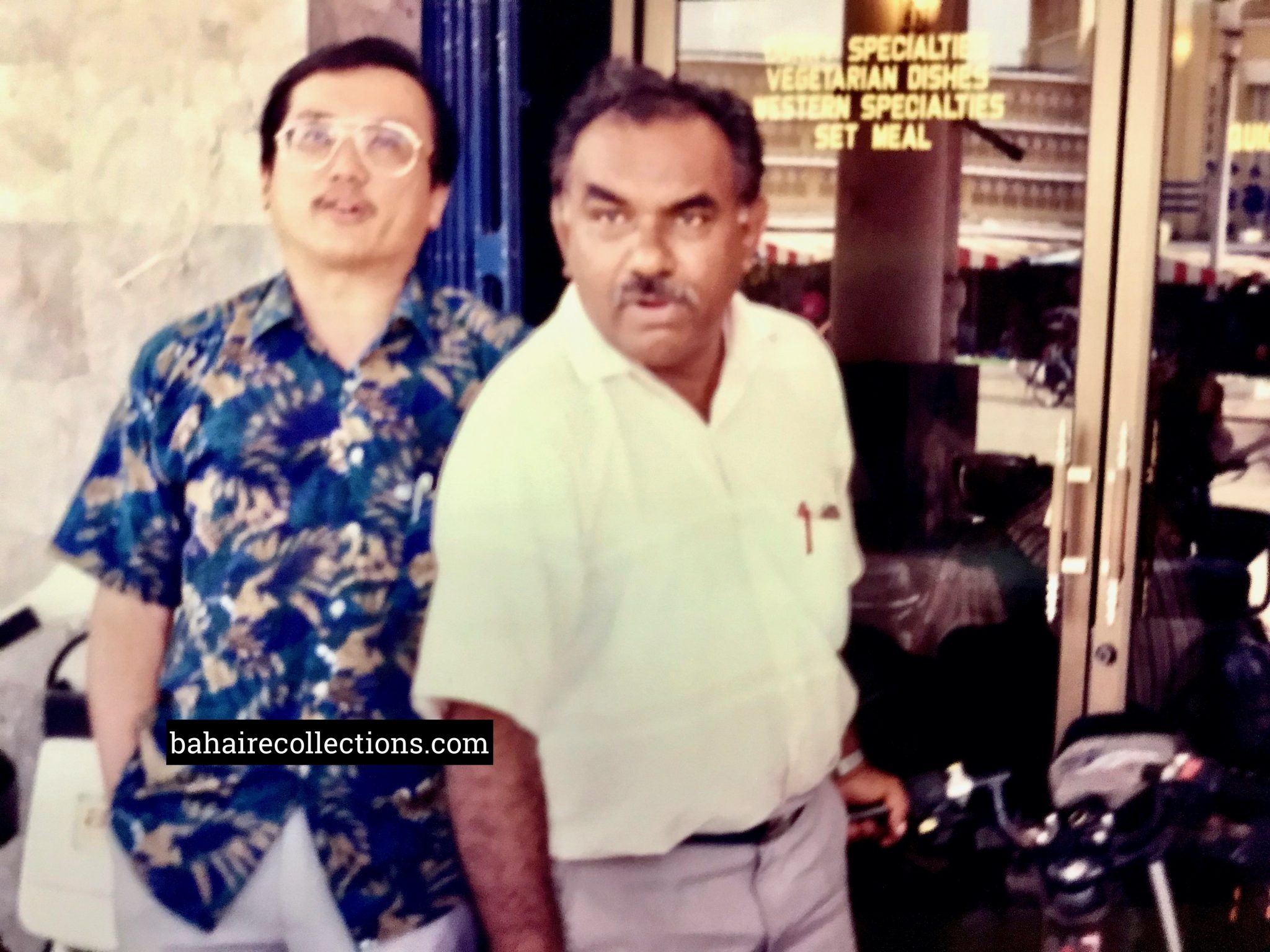
Weng Hoe and Raymond Peter getting ready to go for field work in Cambodia
Likewise, he was about the first to be present in community activities and took ownership of the tasks entrusted. When the Project 1000 was launched by the National Spiritual Assembly, to bring in 1000 believers under this plan, Weng Hoe was in the forefront in the teaching field. Likewise, when the Project 2000 was in force he gave the fullest support in ensuring its triumph in his own way. Weng Hoe was committed to the study of the Ruhi books from the time of its introduction in the community.
Weng Hoe well balanced the Faith and his family needs. He served in such a way that his family was not neglected and looked after the family’s needs in such a way that he still had sufficient time to serve the Cause. At home he was a very loving son to his aged mother and ever supportive to his siblings in every way. Weng Hoe always had the greatest admiration for the elders in the Cause. Out of his love for Yankee Leong, the first enlightened soul to accept the Faith in Malaysia, Weng Hoe named his eldest son Ken Leong in remembrance of that saintly figure.
It has to be mentioned that as far as possible Weng Hoe never missed meetings with the Hands of the Cause. Likewise he attended all, if not most of the National Conventions, Teaching Conferences, Summer Schools and Winter Schools, unless situations did not permit. He was to be seen in almost all Bahá’í events, not only to participate, but also to support them. To him language was not a barrier and was also there for gatherings held in other languages. And he likewise never missed attending both marriages and funerals of believers, as far as possible.

Fund raising project held in the premises of the former Bahá’í Centre at Lorong Titiwangsa in Kuala Lumpur on the occasion of the Intercalary days, 2004. Weng Hoe stands second from left
There were yet two wishes that he had been contemplating for many years. He had a strong desire to produce a pictorial presentation of the history of the Faith in Subang Jaya community, and to write the history of the Petaling Jaya community.
When he came into the Faith he was one of the few who had a camera and had been snapping hundreds of photographs. He had hundreds of photos that he had snapped from 1970 to 2020, with his famous Olympus Camera. They were all in films and was worried with efflux of time they would degenerate in quality and the colour may fade away. Some were without dates and mention of places where they were taken, while as for others he was not able to place the right captions. Just two months before his passing, Weng Hoe then sent over all his photographic collections to the National Bahá’í archives of the National Spiritual Assembly for safekeeping.
Weng Hoe seemed to have had some premonition that his days were approaching. He was speaking the same language to a few believers, just two months before he passed away. One of them was Dr. Leong Yow Peng, member of the Local Spiritual Assembly of Subang Jaya. In his message to Dr Leong he wrote, “If I am not around due to unforeseen circumstances, I want to let the Local Spiritual Assembly to know that all my albums and archives records which are in my possession be handed over to the Assembly. I have also told the same to my wife that my archives comprising photos from 1970 to 2020 in about 30 albums, and some in digital format be passed to the community as my last Will to the community. I am getting old and must prepare for any eventuality.” In the conversations and actions of his last days it became too apparent that he had a premonition that his days were drawing to a close.
And true enough he passed away suddenly, most unexpectedly and so soon to the shock of the family, friends, and community. His desire to write the history of Petaling Jaya remained unfulfilled, but he for sure has become part of the history of Petaling Jaya, Subang Jaya, Kuala Lumpur and Malaysia as a whole. And though he could not come out with the history of the Faith in some parts of the country from 1970 to 2020, flipping through historical albums would have his photographs well in place.
Weng Hoe had some rare qualities and virtues that need special mention. Having understood the Faith well, he developed a burning love for the Cause and developed a motto that he used as his guiding light throughout his life. He served with a singular mind and heart and his bidding aim was never to procrastinate. He took ownership of the needs of the Faith as though carrying out his own family’s tasks. Weng Hoe was highly responsible and had a great sense of determination and perseverance in completing both the family tasks and Bahá’í tasks entrusted. He was very organized, methodical, and neat in discharging his duties. He followed a strict sense of committing and giving the best in all his undertakings. Every day, almost like clockwork he will have something to do for the Faith. He used to be stressed out whenever some important tasks had to be completed. The one most admirable deed of Weng Hoe was to complete the minutes of the meetings of the Local Spiritual Assembly efficiently and on time. Such meetings would end close to midnight and Weng Hoe would return home and start typing out the minutes, which he would complete close to early dawn on many occasions. “When there is a Bahá’í task to be completed today, I do not believe in postponing it to tomorrow,” was the stand he always took. Weng Hoe shall also be remembered for his contribution for the community through his open, frank, and mature consultation at Feasts, Cluster Reflection meetings and at Ridván elections. He could be quick-minded and sharp tongued, and yet had no malicious intentions. The greatness of the man was that he would calm down the next minute after any exchange of words and would move on as nothing had transpired. By all accounts Weng Hoe was a warm-hearted believer. He was always there to assist and console people in distress, and gave the fullest encouragement when believers arose to serve, with no traces of rancour, hate or jealousy.
As an individual member of the community, he was an ardent supporter of the Local Spiritual Assembly and gave his wholehearted support for the institute process. Weng Hoe laughed a lot and made others laugh as well. He was sporting especially during Naw-Rúz day celebrations, he would dress up to the occasion, and even take to the stage to dance as well, with such a sporting spirit. He would liven the crowd. From the time he accepted the Faith, Weng Hoe was fully involved and immersed in the Faith with a relentless energy and dedication leaving room to suspect if he at all had any time to move in the outside world.
Thus ended the life of yet one more star-servant of the Cause in Malaysia. In the half a century of earthly life, Weng Hoe had won numerous friends both within and outside Malaysia. His was a life well lived as a good son, husband, father, father-in-law, and grandfather. He shall be remembered by the community of the Greatest Name as one who had served relentlessly and set an exemplary path of services for current generations and generations yet to be born to emulate. It is our ardent hope and prayer that Bahá’u’lláh may reward Lum Weng Hoe the fullest share of divine blessings for his labours in this world, performed with so much commitment, zeal, and sincerity.
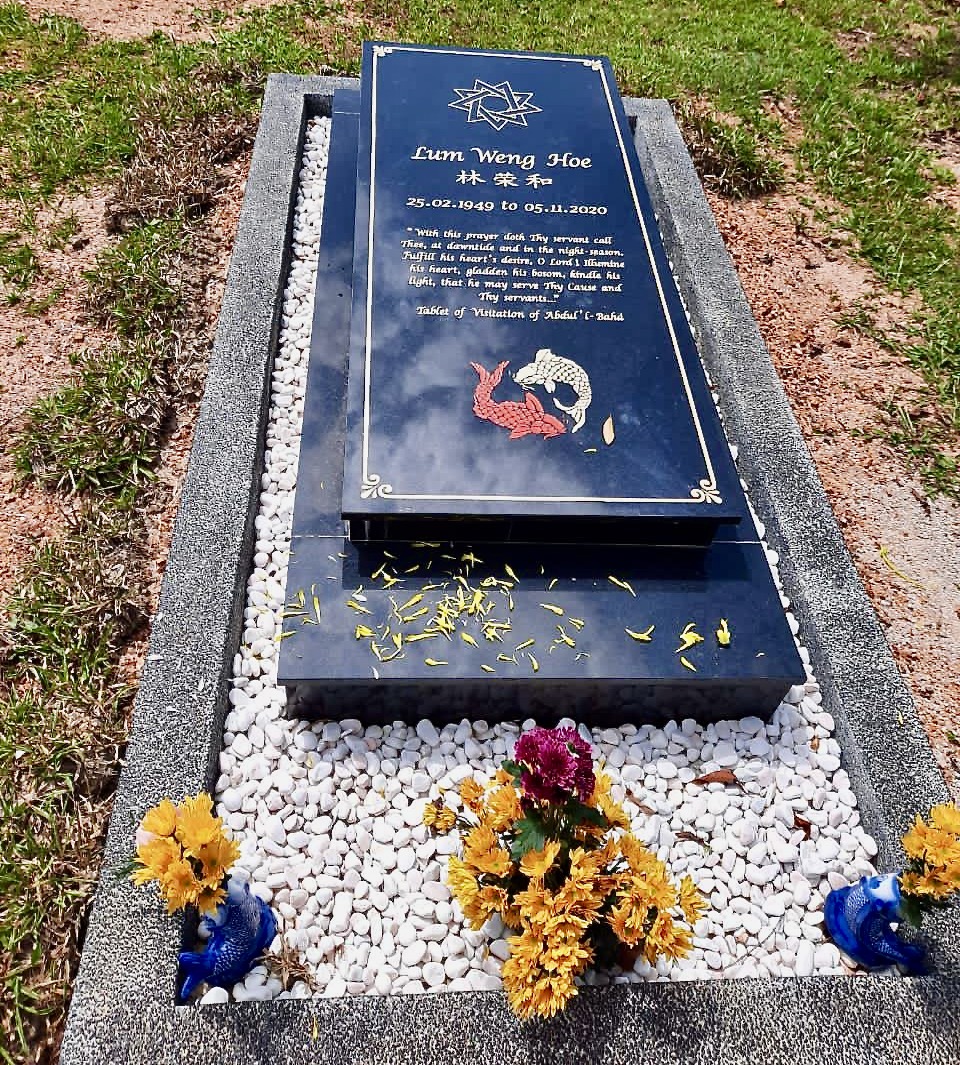
Thy Trust hath been returned unto Thee. It behooveth Thy grace and Thy bounty…
– Bahá’u’lláh
A. Manisegaran
31 May 2022
Copyright@bahairecollections.com
You may leave your comments at: info@bahairecollections.co